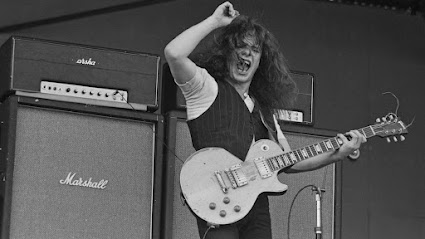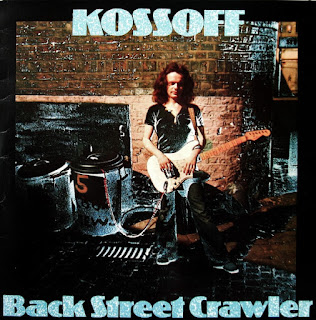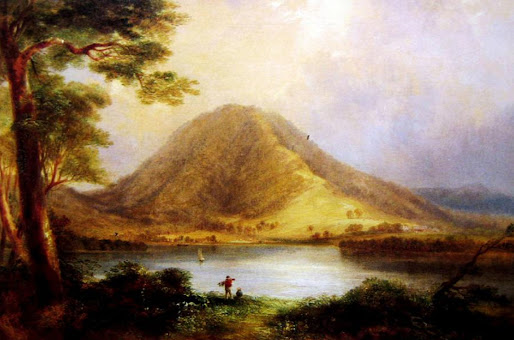Paul Kossoff's guitars
| Black Cat Bones 1966-68 | Free Live! 1968-72 | Free, Sydney 1971 | Gigs 1968-73 | Paul Kossoff Guitars | Posters | Walk In My Shadow 1968 | Wishing Well 1972 |
Contents
- Confusion
- Guitars
- Videos
- Interview 1970
- References
----------------------
1. A confusion of riches
In determining the electric guitars used by Paul Kossoff (b. 14 September 1950) during his brief, decade-long professional career (1966-76), and not having read Paul Kossoff : All Right Now - The Guitars, The Gear, The Music, it is necessary to consider a number of possibilities from those he is said to have used between his initial acquisition of an electric guitar in 1960 through to his death on 19 March 1976 (James 2017, Kopilovic 2022). In approaching this topic, there is some confusion when comparing various websites and YouTube videos regarding the precise periods of ownership and usage, and the actual guitars. Most were owned by Kossoff, but some were also borrowed. Various statements made in print and on the internet do not always line up with others, or with the photographic evidence, especially from Paul's earliest years prior to joining Free in April 1968. For example, in Michael Leonard's article Free Spirit: The Genius of Paul Kossoff (18 March 2013) the following is stated:
Performing was in his family genes – his father was the noted British actor David Kossoff – and he took classic guitar lessons for six years up until his early teens [i.e., 8 to 13], but had pretty much stopped playing until he saw Eric Clapton play with John Mayall’s Bluesbreakers at The Refectory in north London [on 22 April 1966]. The gig changed his life. “I was about 16,” he later recalled. “[My first guitar] was an Eko or something like with a lame gold finish and a billion knobs. Soon after that I got myself a Gibson Les Paul Junior, which was the cheapest Gibson around at the time. Then I had this obsession about getting a ‘real’ Les Paul after seeing Jeff Beck and Eric Clapton play them.”
As no dates are given for the purchase of his first guitar - the dreaded Eko - and we have a circa 1961 picture of Paul with his second guitar, a Gibson Les Paul Junior SG, it would seem that the reference in one video to his obtaining the Eko in 1966 is wrong, and that the chronology presented below is closer to the truth, with 1960 as the more likely date. Within that chronology, the following information for each guitar is presented, where known:
[Cat. No.] [Date of purchase or acquisition] [Model + description] [Usage] [Ultimate fate].
-----------------------
2. The Guitars
#1. circa 1960 - Eko. "...with a lame gold finish and a billion knobs." No photograph of Paul with this guitar is known. It was likely purchased by his parents without his involvement, perhaps as a Christmas present. He apparently did not think much of this guitar and sought to replace it as soon as possible. Even by 1960 Paul was becoming a skilled player, due to a natural talent developed through lessons.
 |
| Paul with his Junior SG, circa 1961. |
#2. circa 1961 - Gibson Les Paul Junior SG, cherry red, single pickup. Purchased at Selmers in London, with his father. The SG was released in the US in 1961 and was also called a Les Paul at the time. In the first photograph above a very young Paul (aged about 10) is seen playing next to a young boy on drums, another on rhythm guitar and one singing. This may have taken place in Selmers.
 |
| Paul with his Gibson Les Paul SG, circa 1963-4. |
Paul is also seen holding the SG in a later photograph (above), standing next to a boy on drums, circa 1963-4. In a third photograph (below) Paul is seen with the guitar next to his father, when aged about 14 (1964).
Apparently he used the SG through to late 1965 or early 1966. For a period he had given up playing the guitar, but returned to it around April 1966 after seeing Eric Clapton with his classic John Mayall's Bluesbreakers setup of Les Paul and a Marshall amp. This resulted in him joining Black Cat Bones shortly thereafter.
#3. circa May 1966 - Gibson Les Paul Custom, 1955, black, twin P90 pickups. Purchased from Manny's Musical Instrument Store, New York, by Paul's father. This was used from about May 1966 through to February 1967 with Black Cat Bones. Apparently Paul sold it to Selmers, or used it as a trade-in, possibly early in 1967. Eric Clapton eventually acquired it from them by March 1967.
 |
| Clapton playing the ex-Kossoff (#3) Les Paul with Cream, at the Marquee, London, 21 March 1967. |
Paul then upgraded to a three pickup Black Beauty at this time.
 |
| Free, US tour, June - August, 1969. |
#4. circa February 1967 - Gibson Les Paul Custom, 1957, black, three pickups. Purchased from Selmers, London, where he worked. Possibly used on Tons of Sobs. Exchanged with Kenny King for a 1960 Gibson Les Paul Standard during 1967-68 and then used with Free from April 1968. Later exchanged with Eric Clapton in the summer of 1969 whilst on tour in the US with Blind Faith. Matthieu Lucas of Matt's Guitar Shop currently (2023) owns this 'Black Beauty'.
 |
| Free, US tour, June - August, 1969. |
 |
| Eric Clapton with former Paul Kossoff guitar, US, circa December 1969. |
5. 1967 - Gibson Les Paul Standard, 1960 tiger-stripe (dark?) Sunburst. Used from circa May 1967 to circa February 1968 with Black Cat Bones. Obtained from Kenny King in a swap for the 3 pickup 1957 Les Paul Custom. However, Kenny King reversed the exchange and got the 'Burst back, probably around the time of February 1968 when Paul left Black Cat Bones and in April joined Free.
#6. April 1969 - Gibson Les Paul Standard, 1959. Sanded down / stripped, clear coated. First seen at the Paris gig in April 1969 and later on Top of the Pops in June 1970 and at the Isle of Wight in August 1970. Used until 1974 and then sold for £550. Article.
 |
| Guitar & Bass, May 2017. |
 |
| Playing the ex-Clapton Les Paul dark 'Burst, 1970. |
#7. July 1969 - Gibson Les Paul Standard, 1958, dark Sunburst. Acquired from Eric Clapton during early July 1969 US tour with Blind Faith, in exchange for the triple pickup 1957 Les Paul Custom. Headstock broken following 12 July 1969 Madison Square Garden concert in New York with Blind Faith. It was subsequently repaired. Following his death, the guitar was owned by Phil Harris and then Paul Rodgers, who subsequently donated to the Paul Kossoff charitable fund. It was then sold to a private collector.
#8. September 1970 (Croydon concert) to 1976 - Gibson Les Paul Standard, 1958/59. Damaged in 1972 and repaired. It was Kossoff's main guitar during that period. The origin is not known to this author. This is known as the Kossoff Burst and has been subject to a reissue by Gibson in 2012 of 100 hand-ages replicas and 250 VOS versions. Owner: Arthur Ramm (sold it in 2015), Kris Blakely of Songbirds Museum (2018). The precise history is as follows:
On 20 October 1972 near the end of a gig at the Mayfair Ballroom, Newcastle, Paul threw the guitar into the air and accidentally broke the neck. He then briefly used Arthur Ramm's 1968 Goldtop for two encores, then asked if he could swap it for the broken guitar. Ramm said OK, as long as he got the broken one fixed and lent him the stripped 'Burst used at the Isle of Wight gig. He eventually returned it and got his Goldtop back when the broken guitar was fixed. The latter was briefly swapped with John Porter of Roxy Music for a black, three pickup Les Paul Custom. After Kossoff died, Ramm purchased the repaired 'Burst for £700 from Paul's girlfriend Sandie Chard.
Phil Harris on the 1959 Paul Kossoff Les Paul Burst, Fried Okra, 18 May 2014, YouTube, duration: 20.38 minutes. Harris play The Hunter and Walk In My Shadow.
#9. 1971 - Fender Stratocaster, 1957, white. Used through to 1976. Appeared on the promotional film for My Brother Jake, recorded for Top of the Pops on 13 June 1971.
In summation, Paul Kossoff's electric guitar ownership and usage appears as follows, based on an approximation of acquisition dates and with references to the numbering above:
- 1960 - Eko, gold. #1. Fate unknown.
- 1961 Gibson Les Paul Junior SG, 1961, cherry red. #2. Fate unknown.
- May 1966 - Gibson Les Paul Custom, 1955, black, 2 pickups. #3. Sold or traded by Kossoff and acquired by Eric Clapton, March 1967.
- January 1967 - Gibson Les Paul Custom, 1957, black, 3 pickups. #4. Lent by Kossoff in January 1967 & returned to him in February 1968. Subsequently acquired by Eric Clapton, July 1969.
- mid' 1967 - Gibson Les Paul Standard, 1960, sunburst. #5. Borrowed by Kossoff & returned February 1968.
- April 1969 - Gibson Les Paul Standard, 1959, sunburst, sanded down. #6. Sold by Kossoff 1974.
- July 1969 - Gibson Les Paul Standard, 1958, dark sunburst. #7. Sold by Kossoff's family.
- September 1970 - Gibson Les Paul Standard, 1958-59, sunburst. #8. Sold by Kossoff's family.
- May 1971 - Fender Stratocaster, 1957, white. #9. Fate unknown.
During the years 1972-6 Paul is also known to have briefly used three borrowed guitars - a Les Paul Goldtop and a black Les Paul Custom. At a1975 gig at the Sunderland Lugarno by Back Street Crawler and broke a string after about the second number and replaced his guitar with a dark 'Burst, likely #7 above.
-------------------------
3. Videos
* Paul Kossoff - History of his Guitars, The Guitar Show, YouTube, duration: 19.08 minutes.
* Forgotten Frettmasters #15 - Paul Kossoff, YouTube, 25 November 2021, duration: 16.59 minutes.
--------------------
4. Interview 1970
The following article appeared as Me and My Music, Disc and Music Echo, 20 June 1970:
PAUL KOSSOFF, 19 year old lead guitarist with Free, currently in the charts with All Right Now, has been with the group since it formed two years ago. Paul was previously with Black Cat Bones and before that had “many jobs”. He owns two Gibson Les Pauls, which he uses through a stack of Marshall equipment. Also owns a “cheap but nice” acoustic and classical guitar. Lives in Covent Garden.
“I had classical lessons when I was younger. I don’t play classical now very much, I’ve let it slip. I don’t think what I learned really helped me, because the two things are so separate. It just gave me the basic thing of what to do with my fingers. I’ve been in Free for two years and before that I played with Black Cat Bones for a while, and before that, nothing. I had many jobs - none of them very interesting. I suppose I first got interested in blues when I used to go to clubs where people like [John] Mayall, the Yardbirds, the Artwoods and the Pretty Things played. But I wasn’t really aware of things. I was only 15 or 16 and I didn’t know who the groups were. Free started as a blues band really, but none of us wanted to play blues in the accepted way and we were all moving away from it, going the way we felt. We’ve always thought of Free as a unit rather than individuals. When we started, most blues groups were doing long solos, which I always found sloppy. We’ve always tried to make it tight.
The single is one of the tracks we did for the album we’ve just finished. We just didn’t know how it would do. It’s not a complete indication of what we’re like. Obviously it is part of us but it’s a frivolous part of us. We’re generally more serious. But our music is simple; the single is simple. We just write and play songs. We don’t do long complicated arrangements with just a few words in them. As I said, we started bluesy and that influence has remained, because of the line-up and because of the people we are. My playing used to be very aggressive and tense. It’s still fairly aggressive but now it’s more relaxed - because the band has slowed it down and made it a bit more melodic.
I don’t write much. Most of it is done by Paul and Andy. Most of the songs we do on stage and on the albums are theirs. I don’t have a big turnover. Some people get ideas all the time, but my ideas don’t come very often. I like listening to lots of things - Aretha Franklin, Otis Redding, Sweet Inspirations, James Brown, Isaac Hayes - and the bands that play on Stax records, the bands that play with Aretha, the musicians they use really swing. That’s how we like to play. We’d like to be as close as those people with that feel of unity. But I suppose that anything I listen to will influence me. Perhaps everything that happens to you has an effect.
Music is all important to me because it’s all I’ve got. I couldn’t work doing anything else for a living. I like every aspect of it. I even like touring, although I find it tiring. We’re doing a tour on the Continent soon with Traffic and Bronco. The satisfaction from a good gig makes it all worthwhile. You are as good as your last gig; you feel as good as your last gig. We are not playing as much as we used to now. We do about four or five gigs a week, usually only four. We sometimes used to do 10 or 15 on the trot. I wouldn’t mind working that much again. I certainly wouldn’t like to do less than we’re doing now. If we’re off for a time we don’t know what to do with ourselves. We only rehearse now and again. I play quite a lot at home. I don’t actually sit down and practice or work phrases out, or anything like that. I just sit down and plonk around when the mood takes me - which is quite often.
I think albums can afford to be serious because people hear them over again and have time to listen and enjoy or understand, whatever. We tend to be more subtle and gentle on record. With an album a group has done it. With a gig, they are doing it. We’re very critical of our own gigs. A bad gig is awful. We’re serious from that point of view. If it’s a good gig it swings and everything is easy. If it is a bad gig, it is forced. It takes a long time for a group to find a direction. All the time it’s been slowly developing until we know each other really well and know each other’s limitations. Its been like a training, working the way we do. I think that if you become too successful there is a danger of becoming lazy. Lots of groups make it quickly and never get to their full capabilities. They get frightened to change. I don’t think we could stop on a success formula because we are changing direction all the time. If the success became more important than the music, if the music ever becomes second to anything, then it comes to an end musically. We’re very critical about the way we play. In fact we are probably a little too intolerant. But it’s just the way we are. It causes a lot of pain and frustration but it’s also very rewarding.”
--------------------
5. References
All right WOW ... Free legend Paul Kossoff's '59 Gibson Les Paul up for £250,000. Express, 8 December 2015.
Bacon, Tony, Legendary Guitars: An Illustrated Guide, Chartwell Books, New York, 2018, 288p.
Bitoun, Julien, Guitars & Heroes: Mythic Guitars and Legendary Musicians, Firefly Books, New York 2018, 240p.
Clayton, David, and Todd K. Smith, Heavy Load: The Story of Free, Moonshine Publishing, 2003, 300p.
Forgotten Frettmasters #15 - Paul Kossoff, YouTube, 25 November 2021, duration: 16.59 minutes.
James, J.P., Paul Kossoff : All Right Now - The Guitars, The Gear, The Music, Troubadour Publishing, 2017, 424p.
Kopilovic, Dan, Paul Kossoff's Guitars and Gear, Groundguitar [website], 2 October 2022.
Kossoff Burst, Wikipedia, accessed: 26 July 2024.
Moon, Grant, The unlikely life story of Paul Kossoff's guitar, Louder, 6 November 2015.
Paul Kossoff - Free's Legendary Guitarist, Vintage Guitar Magazine, May 2000.
Paul Kossoff - History of his Guitars, The Guitar Show, YouTube, duration: 19.08 minutes.
Paul Kossoff's 'Stripped' Les Paul, Guitar.com, 28 April 2017.
Paul Right Now: Paul Kossoff's 1959 Gibson Les Paul up close, Guitar.com, 26 July 2015.
Perry, Frank, A Tribute to Paul Kossoff, Free Appreciation Society, 67, March 1996. Copy at Internet Archive.
---------------------
| Black Cat Bones 1966-68 | Free Live! 1968-72 | Free, Sydney 1971 | Gigs 1968-73 | Paul Kossoff Guitars | Posters | Walk In My Shadow 1968 | Wishing Well 1972 |
Last updated: 31 July 2024
Michael Organ, Australia














Comments
Post a Comment